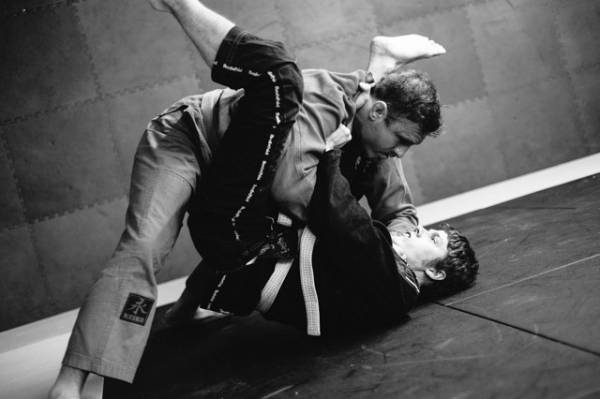Get in the Zone (of Proximal Development) in Your Coaching
The community aspect of athletic activity is important for multiple reasons. Our sports communities provide support, reality checks, and useful information about appropriate behavior. And notably, our community connections are also vitally important influences on our actual learning.
For as long as I’ve been training jiu jitsu, from my very earliest, flailiest experiences up to the present, my teachers and training partners have helped me achieve more in partnership with them than I would be able to by myself. Nowadays, I find myself doing for less experienced practitioners what my teachers have always done for me: using my knowledge to set them up for success. For instance, let’s say we drilled a triangle sequence during the technique part of class. During the rolling part, if my partner has significantly less experience than I do, I might purposefully place myself in a situation where s/he can execute the techniques we worked on earlier in the class.
Sometimes the athlete sees the opening right away and takes advantage, sometimes my simply asking, “What do you see here?” does the trick, and sometimes it requires an overt comment like, “Here you can execute the techniques we worked on earlier today,” accompanied by verbal cues at each step. Thus, depending on the athlete’s needs, I am able to provide assistance to help him/her accomplish more than s/he would be able to without that assistance.
In learning theory, the role I am playing in this scenario is known as the “more knowledgeable other” or “more capable other,” and the mental and physical space within which the athlete and I are interacting is called the “zone of proximal development.” In his seminal 1978 book Mind in Society: The Development of Higher Psychological Processes, psychologist Lev Vygotsky defines the ZPD (as educational types like to refer to it) as “the distance between the actual developmental level as determined by independent problem solving and the level of potential development as determined through problem solving under adult guidance, or in collaboration with more capable peers.”
So what’s the “so what” here? This probably sounds like what many of us already do as coaches and teachers, no? We help our athletes and students along, enabling them to do more, with support from us, than they would be able to otherwise.
Well, how many of you have had a coach-athlete interaction that goes anything like this: “Okay, Athlete X. I’m going to walk you through this sequence of movements. Let’s start with you putting your left foot on your partner’s hip. No, your left foot. Your LEFT foot. Left FOOT. No, your LEFT FOOT. No, YOUR left foot. Okay, relax. I’m going to take your left foot and place it where it belongs. OW! I know you didn’t mean to kick me. It’s okay. Let’s take five.”
Sometimes, I hate to admit, I have shaken my head after an encounter like that, wondering what on earth is wrong with the athlete. Well, the answer is: nothing. What’s wrong is what I’m asking of the athlete. It turns out that Brazilian jiu jitsu is very demanding, on cognitive, neurological, muscular, and emotional levels, especially for beginners, and if an athlete cannot perform what I am asking, I need to ask something different – I need to be in the right zone with them.
 More recently, when I teach or coach, the concepts of the ZPD and the more knowledgeable/capable other have helped me understand that sometimes I may be asking too much of someone, even if I believe I am effectively scaffolding them (another term associated in learning theory with the ZPD). Maybe they just aren’t in this particular zone yet. That’s neither good nor bad. It’s just useful information that can help me better tailor my coaching so as to more effectively set up athletes for success.
More recently, when I teach or coach, the concepts of the ZPD and the more knowledgeable/capable other have helped me understand that sometimes I may be asking too much of someone, even if I believe I am effectively scaffolding them (another term associated in learning theory with the ZPD). Maybe they just aren’t in this particular zone yet. That’s neither good nor bad. It’s just useful information that can help me better tailor my coaching so as to more effectively set up athletes for success.
Understanding the learning process in this way helps me as a coach in several ways. First, it enables me to remain more patient than I would otherwise be able to, because I understand the mechanism at work. I know the athlete is not being obtuse and is certainly not uncoachable. Second, it gives me useful feedback about how I might more effectively adjust my expectations and my requests of the athlete toward a more successful result. I can reposition the ZPD to make sure the athlete is squarely in it. And finally, it reminds me of how inherently social effective learning is; if we want to make sure we help our athletes do more than they believe they can, we must believe it for them first and demonstrate that belief in every interaction we have with them.
How might you make the concept of ZPD work for you, whether as a coach or as an athlete? Post your observations to comments.
Photo 1 courtesy of Shutterstock.
BJJ photo provided by David Brown Photography.
The post Get in the Zone (of Proximal Development) in Your Coaching appeared first on Breaking Muscle.
—————
TRANSCOM ISP – Free Sigma HSE Email
Level 6 Domain Names are FREE – Register Now.
